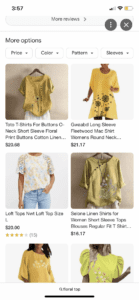Google released a new AI tool that lets consumers virtually try on clothes. It could usher in major changes for ecommerce, according to some experts.
The tool uses generative AI to “reflect how [a clothing item] would drape, fold, cling, stretch and form wrinkles and shadows on a diverse set of real models in various poses,” senior direct of product for Google Shopping Lilian Rincon wrote in a statement. Rincon says the tool is inclusive of a wide variety of shoppers, with “ different skin tones, body shapes, ethnicities and hair types.”
Several brands from Digital Commerce 360’s Top 1000 online retailers in the U.S. are already compatible with Google’s tool. Consumers can try on clothes from Anthropologie (part of Urban Outfitters Inc., No. 30), Everlane Inc. (No. 271), H&M, and Loft (part of Ascena Retail Group, No. 33). More brands will be added in the future, Google says.
Experts predict fewer returns
Virtual try on tools could significantly cut down on returns. Fewer returns might lead to savings for ecommerce retailers, CEO at ecommerce growth agency Heur Chris Raven says.
“Not only will this help brands cut costs and free up time, it will also be positive for the fashion industry’s negative impact on the climate,” he said, due to less waste of returned clothing and savings in shipping costs.
Menswear retailer Otero found success using a different AI fitting room tool from Perfitly. Customers create avatars based on their own body types to try on clothes before adding them to their carts. Otero’s return rate is well below the industry standard at 3%, founder and CEO Steve Villanueva previously told Digital Commerce 360. Villanueva attributes what he calls a “ridiculously low” return rate to Perfitly’s accuracy. There have been some bumps in return rates as Otero and Perfitly tweaked the questions and avatars, he said. But it never exceeded 9% and always settles back between 2 and 3%. That’s far below the industry standard, Villanueva said.
Generative AI can make recommendations to customers
Google’s new AI tool can suggest specific products based on customer preferences. Rincon compared the ability to a worker in a store bringing customers choices based on color, style, pattern, and price. So far, the capability is only available for women’s shirts, Google says, but it can recommend products across brands, unlike in a physical store that’s limited to in-stock inventory.

Google uses AI to recommend similar products across retailers.
“I don’t believe that AI is a passing fad and in order to grow with the current climate, brands must lean into these new technologies and use them to their advantage,” CEO of apparel retailer SilkFred Emma Watkinson said. SilkFred is preparing to launch a similar service that can make outfit recommendations to customers.
Generative AI like Google’s new tool gives retailers the “holy grail” to tailor experiences to clients on a one-to-one basis, Robert Brown, managing director and client executive at digital strategy consulting company BDO, told Digital Commerce 360. AI generates “massive” amounts of data about consumer preferences and needs that retailers can turn into future conversions, he said. The data can also be used to improve loyalty and membership programs.
Potential downsides
Though innovations in AI could boost sales for ecommerce brands, there could also be some negative side effects. “Many people will be deterred by new technology which could potentially see a brand lose customers,” Raven said. Some potential customers could be intimidated and decide not to learn the new technology, he said.
Otero faced the same issue at first. When it first implemented Perfitly, not many customers used it, Villanueva said. Making the avatar the entry point of the site was key to fixing the “up-front complexity” in Otero’s products, Villanueva said. Once customers saw how the retailer’s shirts were designed proportionally to fit their body type, they were much more likely to buy, he says. Otero’s conversion rate is 3%, he shared.
Brown points out that the data generated from retailers using AI, which can be a huge boon to retailers, is also a potential downside. Retailers have the opportunity to misuse data and lose consumer trust, he said. “The more you know about customers, the more possibility there is that people will take advantage of that,” he told Digital Commerce 360.
Sign up
Stay on top of the latest developments in the ecommerce industry. Sign up for a complimentary subscription to Digital Commerce 360 Retail News.
Follow us on LinkedIn, Twitter and Facebook. Be the first to know when Digital Commerce 360 publishes news content.
Favorite